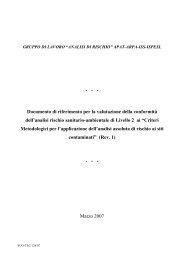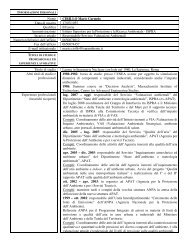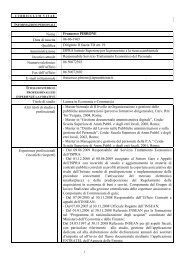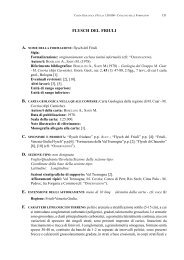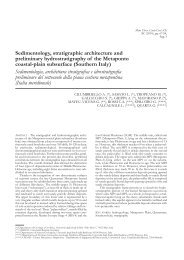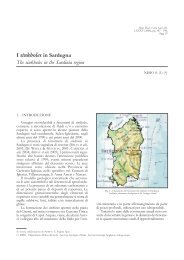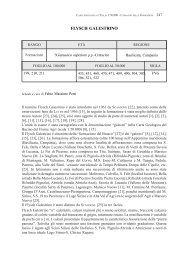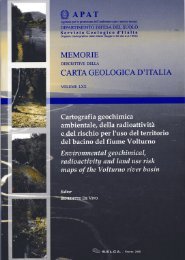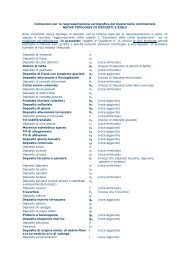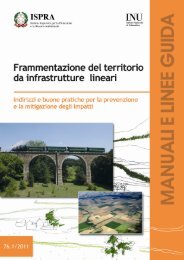Guidebook - Ispra
Guidebook - Ispra
Guidebook - Ispra
You also want an ePaper? Increase the reach of your titles
YUMPU automatically turns print PDFs into web optimized ePapers that Google loves.
Volume n° 1 - from PR01 to B15<br />
B12<br />
B12 -<br />
Leader: M. Sandulescu<br />
black argillaceous shales with olistoliths of Jurassic<br />
basalts, Upper Triassic and Upper Jurassic micritic<br />
limestones, interbedded with basaltic flows, pyroclastics<br />
and epiclastics and sandstones, representing<br />
an olistostrome.<br />
Along the Mureș valley, again after an EW trending<br />
fault, outcrops of the Deva Formation can be examined.<br />
The conglomerates, massive sandstones and<br />
marls are of Coniacian-Santonian age, constrained by<br />
micropaleontological data (Bleahu et al., 1981).<br />
The fieldtrip reaches Deva, a town dominated by a hill<br />
built up by a Neogene amphibole andesite (+ biotite<br />
volcanic neck) with a ruined fortress of the XV th century<br />
on its top.<br />
DAY 6<br />
Deva - Tg.Jiu - Turnu Severin<br />
From Deva, the fieldtrip reaches Hunedoara, a town<br />
famous in the country not only for its metallurgical<br />
plants but also for the beautiful castle, built in the<br />
middle of the XV th century. Its foundations rest on<br />
a cliff of Lower Carboniferous crystalline dolomites<br />
belonging to the Supragetic Units of Poiana Ruscă.<br />
Underlying the dolomites, low-grade iron deposits<br />
were mined representing the basis for the local metallurgical<br />
industry.<br />
From Hunedoara, the road crosses the Neogene Strei<br />
basin.<br />
Stop 6.1:<br />
Crivadia Bridge. Getic Nappe: Lotru basement<br />
and Mesozoic cover.<br />
Between Crivadia and Băniţa, national road 66<br />
crosses the Getic (Austrian) Nappe represented by the<br />
Lotru Group basement and the Lower Jurassic-Lower<br />
Cretaceous cover. Aalenian-Bathonian sandstones<br />
and bioclastic limestones are followed by bioclastic<br />
limestones with siliceous deposits (Lower-Middle<br />
Callovian) and Upper Jurassic-Aptian pelletal and<br />
micritic Urgonian limestones (T. Berza, in: Berza et<br />
al., 1994).<br />
Before entering Petroșani, the Lotru Group is exposed,<br />
consisting of micaschists and micaceous paragneisses<br />
with muscovite, biotite and garnet. They are sometimes<br />
affected by retrogression, by which the primary<br />
minerals are substituted by sericite and chlorite.<br />
The Petroșani Tertiary basin follows, with red Aquitanian<br />
conglomerates and coal-bearing Chattian<br />
sandstones.<br />
Stop 6.2:<br />
Gambrinus Motel. Liassic Schela Formation.<br />
At the confluence of the Eastern and the Western Jiu<br />
(km 125 on national road 66 ), a small road after 150<br />
m leads to the Gambrinus Motel. The Liassic Schela<br />
Formation is exposed along a forest road beginning<br />
immediately before the motel. It consists of black<br />
metapelitic and metapsammitic rocks of Gresten type.<br />
On the southern slope of the Vâlcan Mountains, the<br />
Figure 10 - Schematic cross-section along the Jiu Gorges (Berza, Drăgănescu,in Berza et al.,1994). 1,Tertiary<br />
deposits; 2,Lotru rocks; 3,Upper Cretaceous Flysch with Lupeni limestone klippen;4,Schela Formation;5,Lainici-<br />
Păiuș rocks; 6,Drăgșan amphibolites; 7, Șușiţa Pluton; 8,unconformity; 9, ”decollement”stratigraphic boundary;<br />
10,Alpine overthrust; 11, pre-Alpine overthrust



